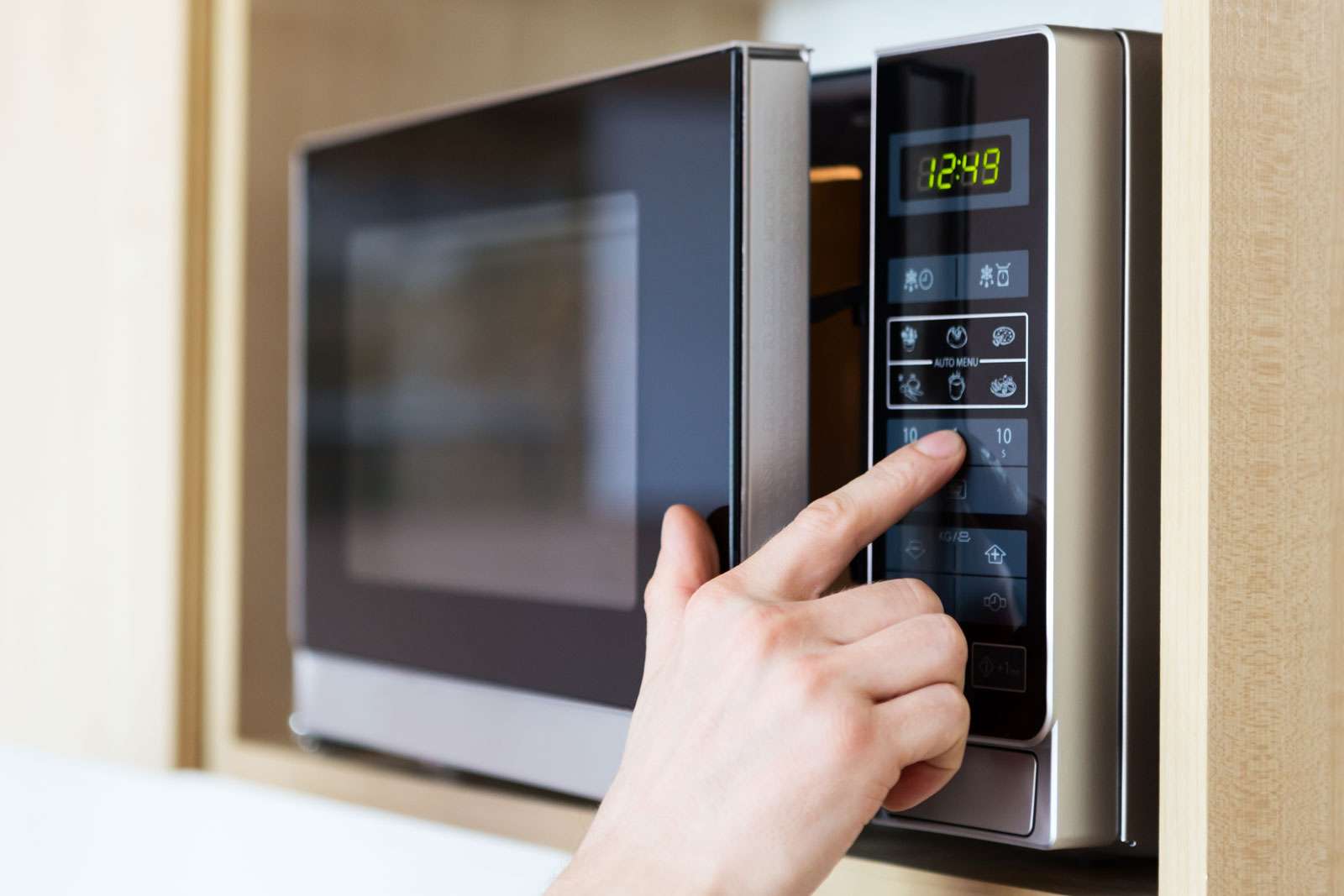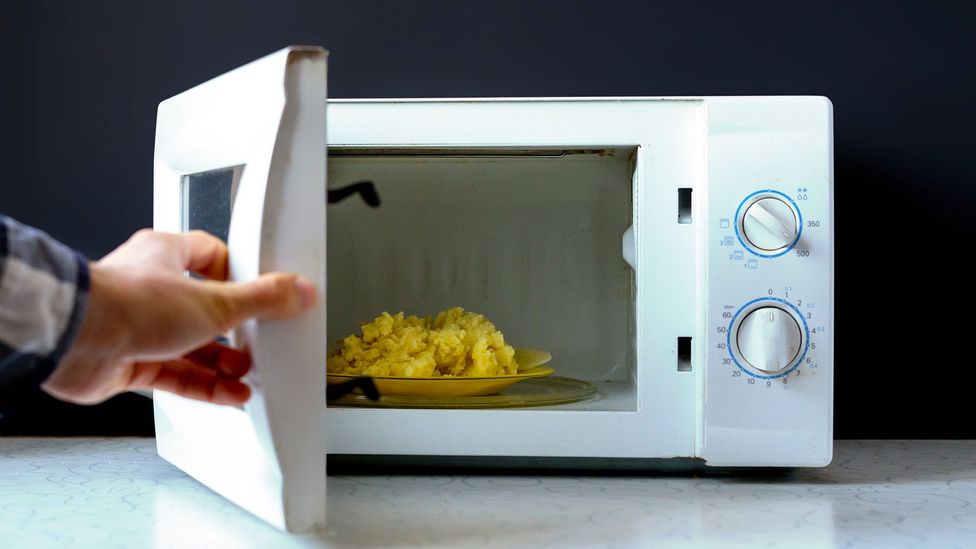What Are Microwaves Lined With? Can You Use Antique Microwaves?

Microwave linings do not contain any lead. A microwave’s inside comprised stainless or galvanized steel that has been enameled. None of this is accomplished by using lead in the production process.
However, lead inside microwaves isn’t the only safety hazard.
So, in this post, we’ll look at all of the significant safety issues, investigate the origins of tales, anecdotes, and urban legends, and go into the realm of microwaves. That way, you’ll be able to make an educated decision on whether to get one or maintain the one you already have.
Let’s get started!
Was there ever a time when microwaves contained lead?
Microwaves have never had lead linings or been made with lead in any way. The outside is usually a one-piece wrap-around aluminum shell, with stainless or galvanized steel inside sections enameled (not made from lead).

Lead in manufactured electronics has been prohibited in Europe for many years. While there is no such limit in the United States, many significant manufacturers are phasing out lead-containing parts.
There is no ignoring the hazards of lead exposure that have been established throughout the years.
Many individuals are concerned that their microwave ovens contain lead. After all, most doctors’ offices use lead aprons to shield themselves from radiation when taking x-rays. However, what appears to be an excellent protective barrier on the body’s surface isn’t always secure on the inside.
Microwave ovens also employ a different sort of radiation than most people believe.
The word “radiation” conjures up nuclear weapons and disease ideas resulting from manufactured radiation.
On the other hand, microwaves employ less harmful radiation that doesn’t have enough energy to produce the biological damage that most people are concerned about.
It is a prevalent misperception that microwave-cooked meals are less healthy.
Some people believe they have been genetically transformed due to the radiation and chemical reactions it induces. There is, however, really nothing to be concerned about unless you are cooking your meal in a box that contains lead, BPA, or phthalates.
What material is used to line microwaves?
A microwave oven’s shell and inside are galvanized or stainless steel, which is then coated in acrylic enamel for a more visually attractive appearance.
If microwaves aren’t coated with lead, you might be wondering what keeps the radiation from escaping and what microwave ovens are made of. Metal is used to line microwave ovens since it is an integral part of their function.
To fill the in of the microwave oven and cook your food, the radiation utilized to heat your food bounces off the metal walls. The long microwaves are also kept inside the chamber by a mesh wire “cage” that prevents them from escaping through the glass. So, where did the rumor about microwaves being laced with lead originate from?
The most likely source of that story is food heated on lead-lined plates, as well as research showing how lead in plates or cookware may leach into food when heated in a microwave. Lead was used in ceramic tableware, bakeware, and other items created before 1950. “Using such plates to ordinary microwave foods might result in the intake of dangerously significant levels of lead,” according to a report given out by the National Library of Medicine.
If you have inherited china or plates from your grandmother or collected vintage cookware, avoid using anything in the microwave. Should the door to a microwave be kept open after use?
Radiation does not leak into the kitchen when the microwave door is left open after usage. On the other hand, a microwave does not require cooling after use. Thus there is no need to keep the door open after use, and the inside light will remain on unnecessarily. Many differing viewpoints on whether the microwave door should be left open after usage.
Some people worry that keeping it closed will allow leftover radiation to escape, exposing you and others to hazardous rays. However, there is no scientific foundation for such fear. EMFs, or electric and magnetic fields, are at the heart of the problem. Microwaves do emit EMFs! EMFs, on the other hand, are divided into two groups:
Non-ionizing: This emits low-level radiation that is deemed safe for humans.
Ionizing radiation is a kind of high-energy radiation that can harm DNA.
On the other hand, microwave ovens employ non-ionizing EMFs and are relatively safe.
And many research has been conducted on the EMFs emitted by microwaves and mobile phones. Still, they all “find no evidence of a relationship between EMF exposure and adult malignancies” (quote from the National Institute of Environmental Health Sciences as linked above). So, if you’re afraid of EMFs, don’t shut the door.
Others argue that you should leave it exposed to cool entirely before using it again. There is no correct or incorrect response to this question. But why don’t you keep it shut? Unlike a standard toaster oven, the microwave does not keep hot for as long after usage.
Because the light stays on when the door is open, it’s also a good idea to close the microwave door after usage. This causes your bulb to burn out prematurely, which is an extra expenditure you may not want to deal with.
Is it safe to use antique microwaves?
The technology in older microwave ovens is safe, especially those manufactured after 1971, but if the door seals are damaged, cracked, or missing entirely, they might pose a safety threat.
Over the years, technology has improved. This is seen in the growth of televisions, the introduction of cellular phones, and the development of the microwave. Manufacturers are constantly attempting to enhance what we have now. They’re also constantly experimenting with new and old materials, uncovering initially utilized items that are now known to pose a health danger, and transitioning to more cost-effective materials.
Microwave oven manufacture was subjected to government regulations in October 1971. Radiation leakage was allowed to 5 milliwatts per square centimeter at a distance of around 2 inches from the oven’s surface under these standards. It also necessitated the installation of two interlocking switches that shut down the oven when the door was opened. That stated this does not imply that all microwave ovens produced before 1971 are harmful, nor does it imply that all microwave ovens made after 1971 are. It all depends on how well they’re doing.

Newer microwaves include several safety measures. Over time, the seal surrounding the door, the metal lining, and even the heating components have all been enhanced to keep you and your family safe.
Some of these parts may be worn out in an older microwave. It might not be as secure as it was when you bought it.
Some radiation may escape if the seal around the door is broken or not functioning correctly, increasing your risk of exposure. But, to be honest, the most significant danger you’d have to deal with is a fire.
You might spark a fire in your microwave if the heating element is damaged and you’re cooking food like popcorn or potatoes.
What is the most OK microwave for health-conscious people?
The Panasonic Microwave Oven NN-SN966S is the most OK microwave for keeping food quality and resolving health problems.
It has almost 3,000 ratings, with nearly everyone being a 5-star rating! It’s an Amazon’s Choice item as well. It has a powerful motor and ample space for large family meals.
However, its Genius Sensor automatically adjusts cooking power and duration dependent on the dishes being cooked.
When it comes to microwaves, there are a lot of individuals who are concerned about their health and safety.
Microwaves are dangerous not because of the radiation but because they cook food in general. Most cooking techniques deplete nutrients, but microwaves, unexpectedly, lose less since they cook quicker.
Microwave ovens are also handier than toaster ovens. Toaster ovens are excellent for browning and crisping, but they take longer to heat up and cook than other ovens.
Instead of depending only on microwave technology to heat food, this microwave additionally employs safe steam to uniformly heat food all the way to the core, eliminating the risk of a chilly or undercooked center.
This microwave also features a unique feature that keeps your food warm until you’re ready to consume it, such as soups, gravies, and desserts.
Conclusion
Hopefully, this has answered all of your questions concerning microwave safety.
The internal lining does not contain any lead, but a metal helps the waves bounce around and fry your food. Microwave oven radiation is also safe because it is not nuclear radiation.
A toaster oven is a good alternative if you’re worried about microwave radiation. However, you will miss out on the microwave’s quickness and convenience.











